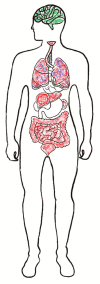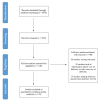SARS-CoV-2-Morphology, Transmission and Diagnosis during Pandemic, Review with Element of Meta-Analysis
- PMID: 34063654
- PMCID: PMC8125301
- DOI: 10.3390/jcm10091962
SARS-CoV-2-Morphology, Transmission and Diagnosis during Pandemic, Review with Element of Meta-Analysis
Abstract
The outbreak of Coronavirus disease 2019 (COVID-19) is caused by severe acute respiratory syndrome (SARS) coronavirus 2 (SARS-CoV-2). Thus far, the virus has killed over 2,782,112 people and infected over 126,842,694 in the world (state 27 March 2021), resulting in a pandemic for humans. Based on the present data, SARS-CoV-2 transmission from animals to humans cannot be excluded. If mutations allowing breaking of the species barrier and enhancing transmissibility occurred, next changes in the SARS-CoV-2 genome, leading to easier spreading and greater pathogenicity, could happen. The environment and saliva might play an important role in virus transmission. Therefore, there is a need for strict regimes in terms of personal hygiene, including hand washing and surface disinfection. The presence of viral RNA is not an equivalent of active viral infection. The positive result of the RT-PCR method may represent either viral residues or infectious virus particles. RNA-based tests should not be used in patients after the decline of disease symptoms to confirm convalescence. It has been proposed to use the test based on viral, sub-genomic mRNA, or serological methods to find the immune response to infection. Vertical transmission of SARS-CoV-2 is still a little-known issue. In our review, we have prepared a meta-analysis of the transmission of SARS-CoV-2 from mother to child depending on the type of delivery. Our study indicated that the transmission of the virus from mother to child is rare, and the infection rate is not higher in the case of natural childbirth, breastfeeding, or contact with the mother. We hope that this review and meta-analysis will help to systemize knowledge about SARS-CoV-2 with an emphasis on diagnostic implications and transmission routes, in particular, mother-to-child transmission.
Keywords: COVID-19; SARS-CoV-2; childbirth; laboratory diagnosis; pandemic; transmission route.
Conflict of interest statement
The authors declare no conflict of interest.
Figures







Similar articles
-
From People to Panthera: Natural SARS-CoV-2 Infection in Tigers and Lions at the Bronx Zoo.mBio. 2020 Oct 13;11(5):e02220-20. doi: 10.1128/mBio.02220-20. mBio. 2020. PMID: 33051368 Free PMC article.
-
The British variant of the new coronavirus-19 (Sars-Cov-2) should not create a vaccine problem.J Biol Regul Homeost Agents. 2021 Jan-Feb;35(1):1-4. doi: 10.23812/21-3-E. J Biol Regul Homeost Agents. 2021. PMID: 33377359
-
Maternal Transmission of SARS-CoV-2: Safety of Breastfeeding in Infants Born to Infected Mothers.Front Pediatr. 2021 Dec 9;9:738263. doi: 10.3389/fped.2021.738263. eCollection 2021. Front Pediatr. 2021. PMID: 34956971 Free PMC article. Review.
-
Coronavirus disease 2019 (COVID-19) pandemic and pregnancy.Am J Obstet Gynecol. 2020 Jun;222(6):521-531. doi: 10.1016/j.ajog.2020.03.021. Epub 2020 Mar 23. Am J Obstet Gynecol. 2020. PMID: 32217113 Free PMC article. Review.
-
Assessment of Maternal and Neonatal SARS-CoV-2 Viral Load, Transplacental Antibody Transfer, and Placental Pathology in Pregnancies During the COVID-19 Pandemic.JAMA Netw Open. 2020 Dec 1;3(12):e2030455. doi: 10.1001/jamanetworkopen.2020.30455. JAMA Netw Open. 2020. PMID: 33351086 Free PMC article.
Cited by
-
Repeat laboratory testing of SARS-CoV-2 is necessary to diagnose COVID-19.J Infect Public Health. 2021 Sep;14(9):1164-1168. doi: 10.1016/j.jiph.2021.07.008. Epub 2021 Jul 20. J Infect Public Health. 2021. PMID: 34391172 Free PMC article.
-
COVID and depression among stratified population groups: a narrative review.Eur J Med Res. 2023 Aug 3;28(1):265. doi: 10.1186/s40001-023-01213-4. Eur J Med Res. 2023. PMID: 37537632 Free PMC article. Review.
-
COVID-19 in a Pre-Omicron Era: A Cross-Sectional Immuno-Epidemical and Genomic Evaluation.Vaccines (Basel). 2023 Jan 27;11(2):272. doi: 10.3390/vaccines11020272. Vaccines (Basel). 2023. PMID: 36851150 Free PMC article.
-
Progress in the Diagnosis and Treatment of COVID-19 in Children: A Review.Int J Gen Med. 2021 Nov 12;14:8097-8108. doi: 10.2147/IJGM.S335888. eCollection 2021. Int J Gen Med. 2021. PMID: 34795516 Free PMC article. Review.
-
Modelling quarantine effects on SARS-CoV-2 epidemiological dynamics in Chilean communes and their relationship with the Social Priority Index.PeerJ. 2023 Mar 10;11:e14892. doi: 10.7717/peerj.14892. eCollection 2023. PeerJ. 2023. PMID: 36923504 Free PMC article.
References
-
- World Health Organization WHO Coronavirus Disease (COVID-19) Dashboard. [(accessed on 18 March 2021)];2020 Available online: https://covid19.who.int/
-
- Chen N., Zhou M., Dong X., Qu J., Gong F., Han Y., Qiu Y., Wang I., Liu Y., Wei Y., et al. Epidemiological and clinical characteristics of 99 cases of 2019 novel coronavirus pneumonia in Wuhan, China: A descriptive study. Lancet. 2020;395:507–513. doi: 10.1016/S0140-6736(20)30211-7. - DOI - PMC - PubMed
Publication types
LinkOut - more resources
Full Text Sources
Miscellaneous

